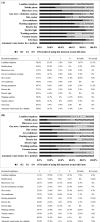Assessment of instrumental activities of daily living in patients with cognitive impairment based on their ability to use household appliances
- PMID: 40134265
- PMCID: PMC12246828
- DOI: 10.1177/13872877251320668
Assessment of instrumental activities of daily living in patients with cognitive impairment based on their ability to use household appliances
Abstract
BackgroundDetecting life disability is crucial in diagnosing dementia; however, early detection has proven challenging with previous assessment scales. This study focused on an individual's ability to use household appliances as a means of detecting life disability.ObjectiveThe objectives of this study are threefold: (1) to compare the ability to use household appliances between the non-dementia and dementia groups, (2) to determine whether the level of life disability based on the ability to use appliances is at the level of diagnosed dementia or non-dementia, and (3) to explore the impact of age and gender on the ability to use appliances.MethodsWe selected 13 essential household appliances for elderly individuals and proposed an instrumental activities of daily living (IADL) assessment tool to evaluate their usage. Our sample consisted of 98 patients with cognitive impairment, divided into a non-dementia group (N = 34) and a dementia group (N = 64). Most participants in the dementia group had Alzheimer's disease or related conditions. Through multiple logistic regression, the model equation aimed to determine whether a subject's functional disability indicated a potential dementia diagnosis.ResultsThe optimal model equation identified the microwave oven and air conditioner as key factors, achieving an area under the curve (AUC) of 0.78. Additionally, analysis by age and gender enhanced the discriminative power of the results.ConclusionsOur proposed scoring system can efficiently determine the degree of life disability by assessing appliance usage, demonstrating comparable discriminatory ability to existing scales.
Keywords: Alzheimer's disease; early dementia; early detection; instrumental activities of daily living; life disability; mild cognitive impairment.
Conflict of interest statement
Declaration of conflicting interestsThe authors declared no potential conflicts of interest with respect to the research, authorship, and/or publication of this article.
Figures


References
-
- Petersen RC. Mild cognitive impairment clinical trials. Nat Rev Drug Discov 2003; 2: 646–653. - PubMed
-
- Petersen RC. Mild cognitive impairment as a diagnostic entity. J Intern Med 2004; 256: 183–194. - PubMed
-
- Albert MS, DeKosky ST, Dickson D, et al. The diagnosis of mild cognitive impairment due to Alzheimer's disease: recommendations from the national institute on aging-Alzheimer's association workgroups on diagnostic guidelines for Alzheimer's disease. Alzheimers Dement 2011; 7: 270–279. - PMC - PubMed
MeSH terms
LinkOut - more resources
Full Text Sources
Medical

